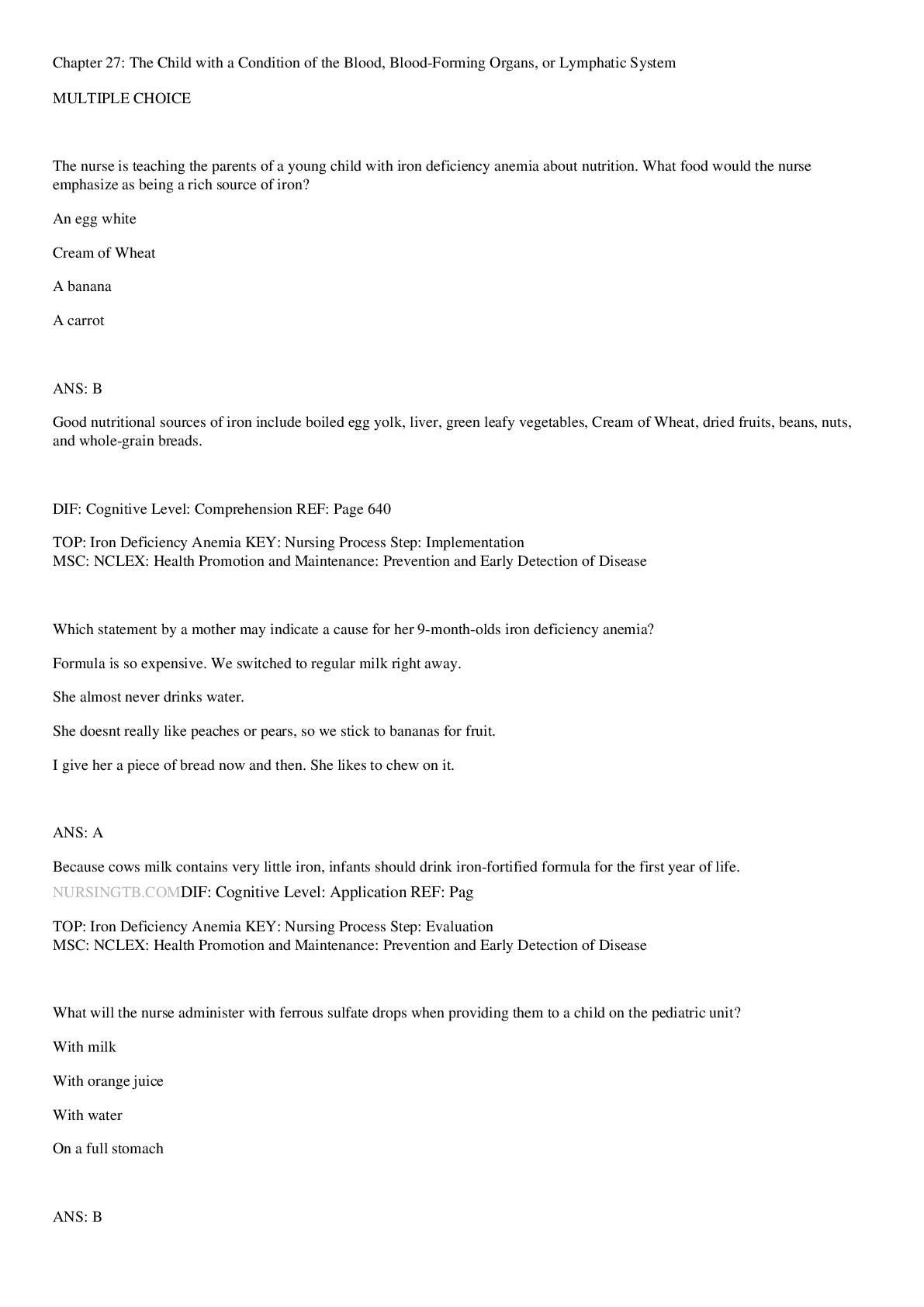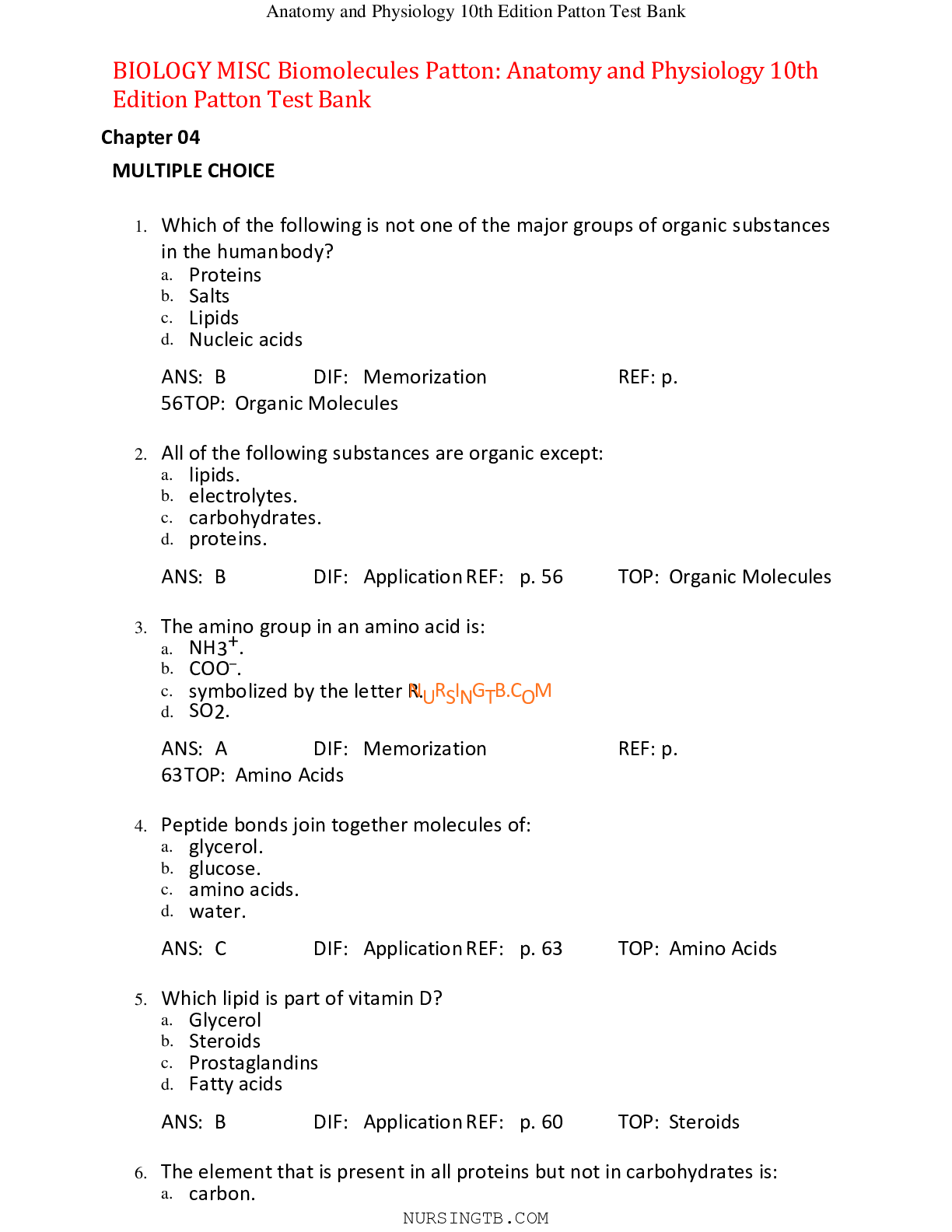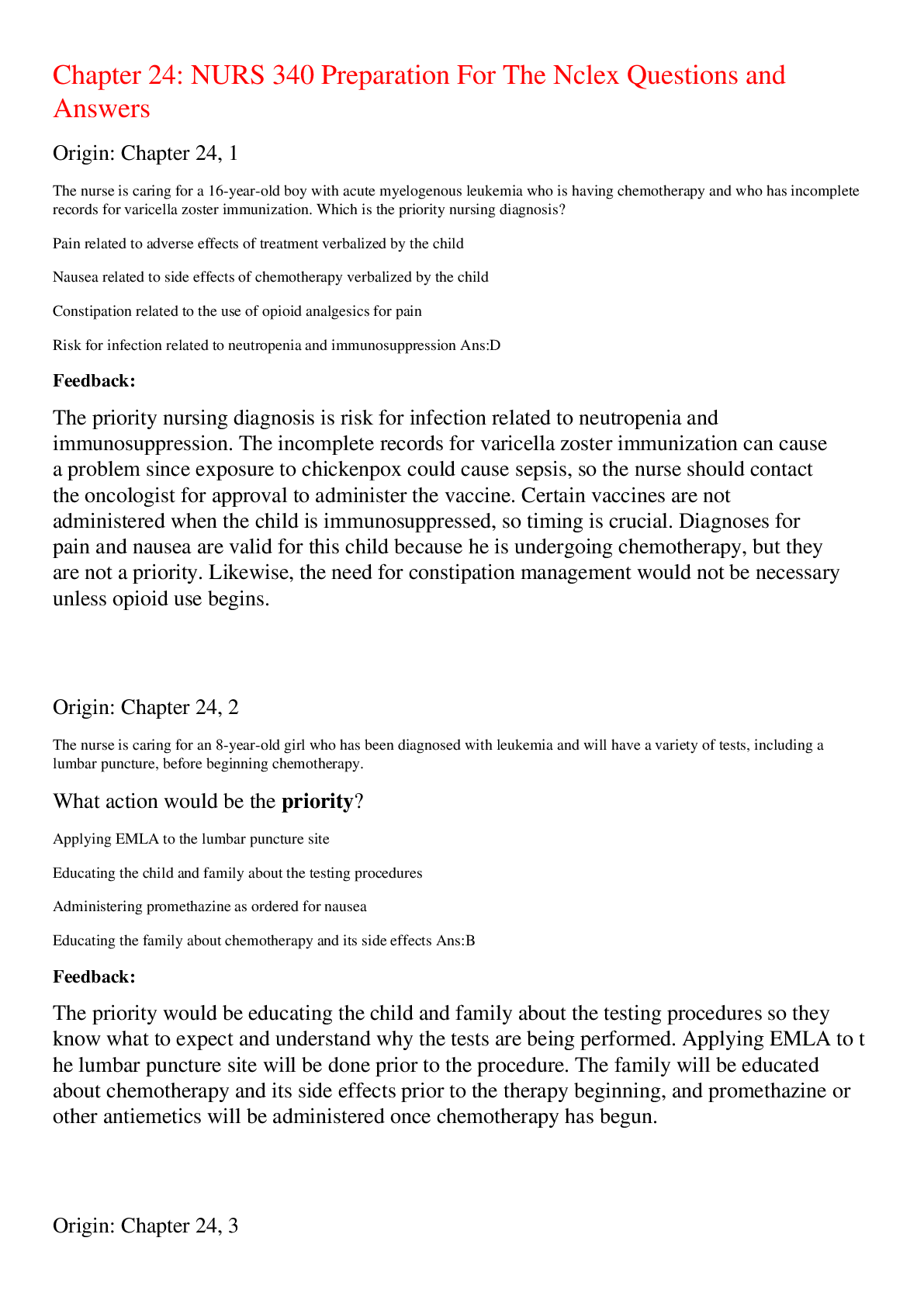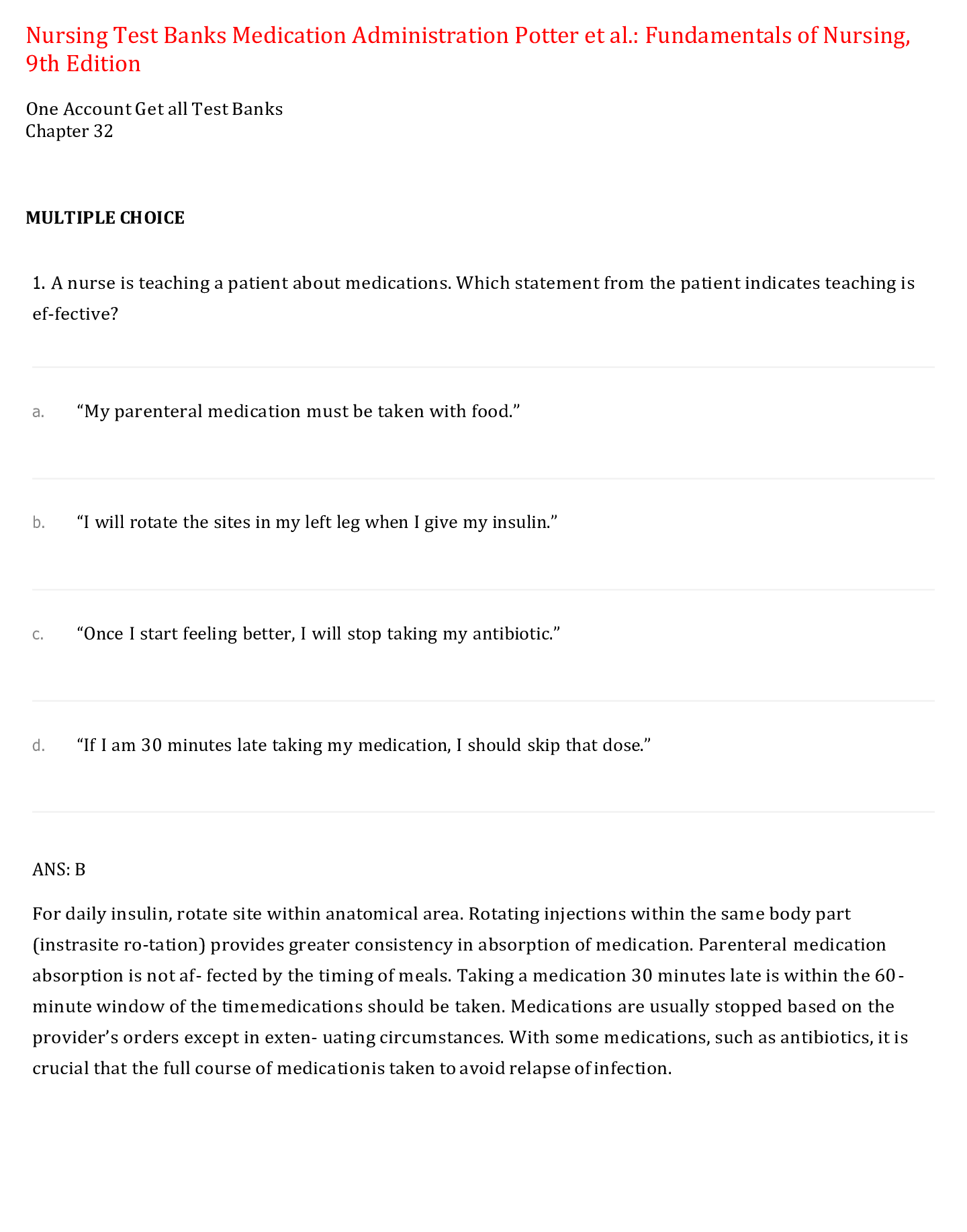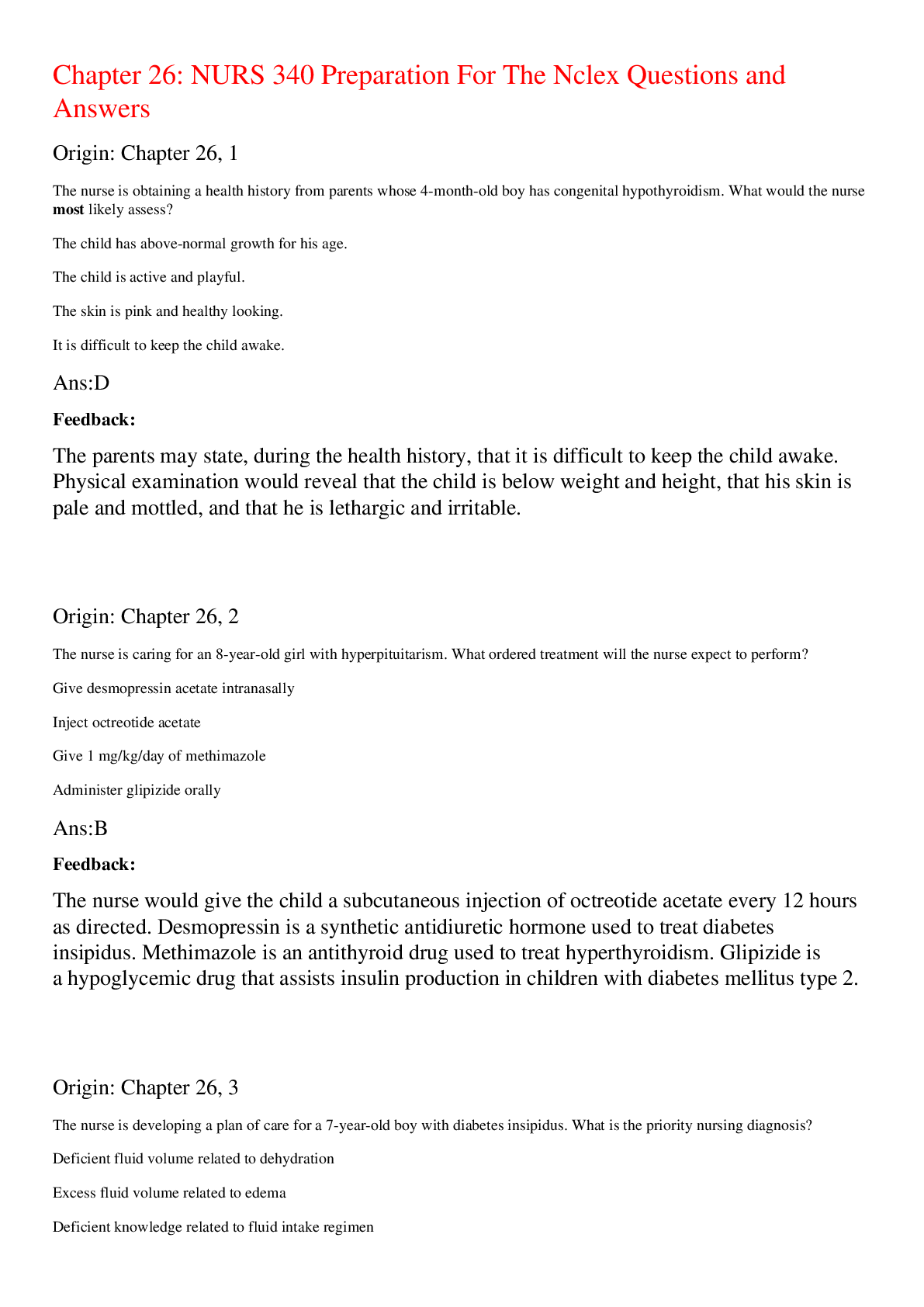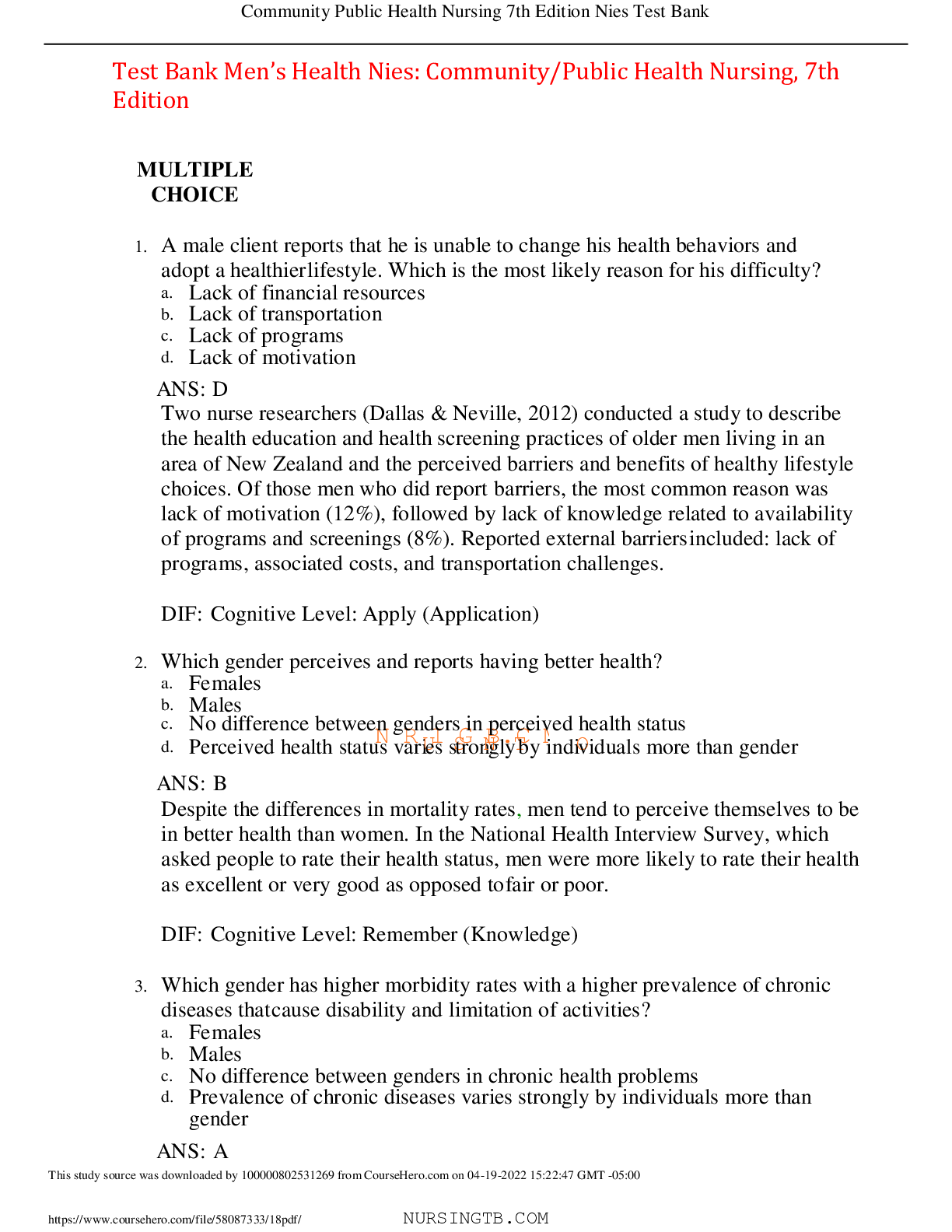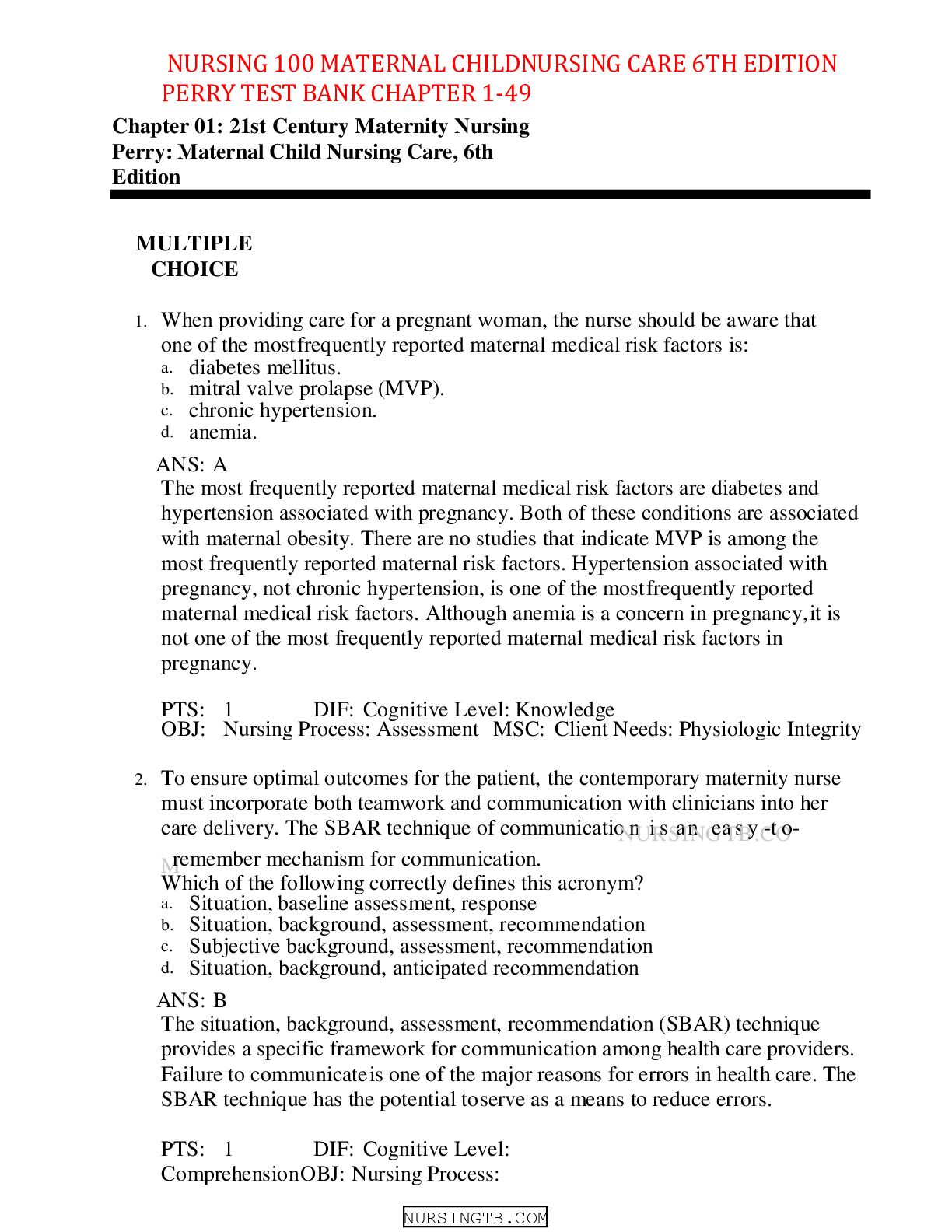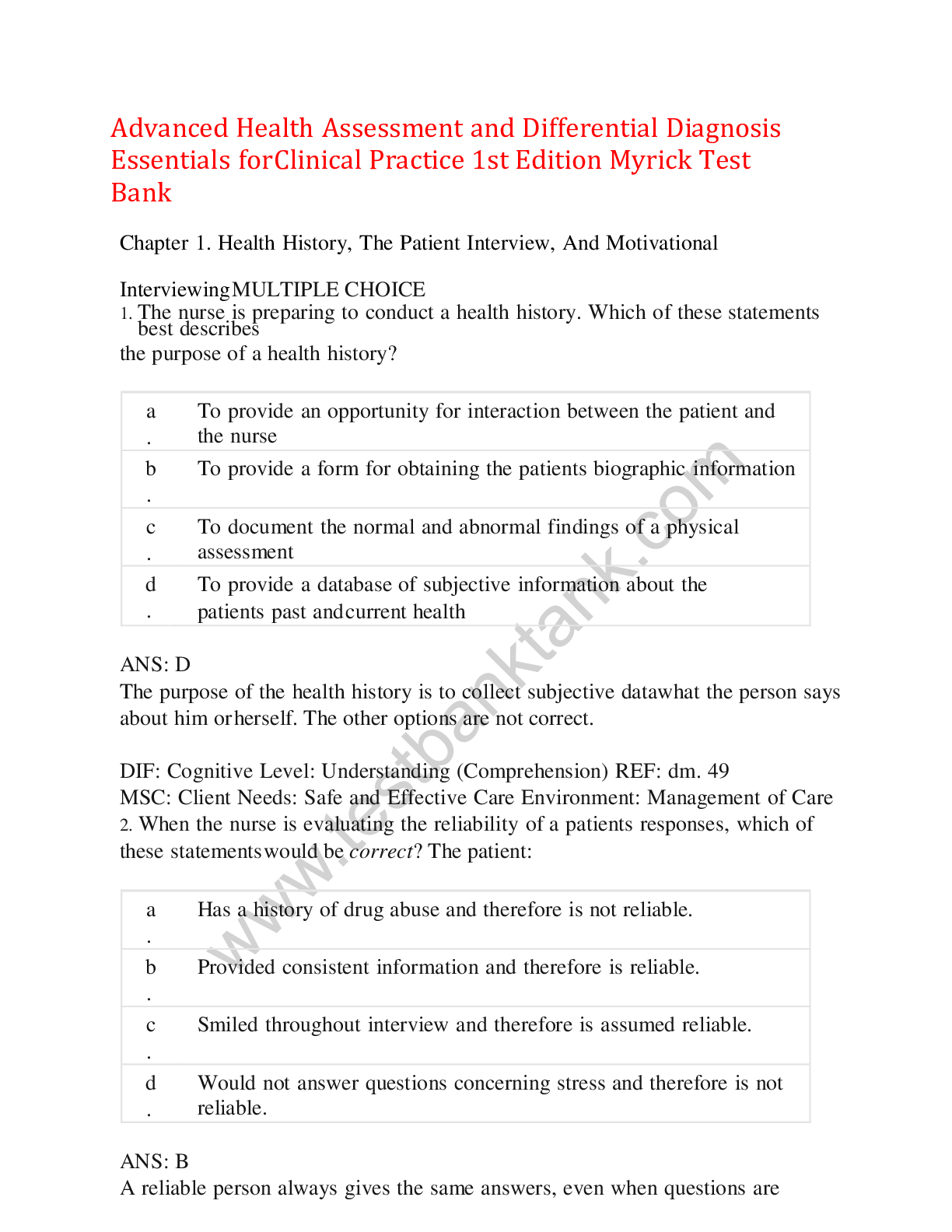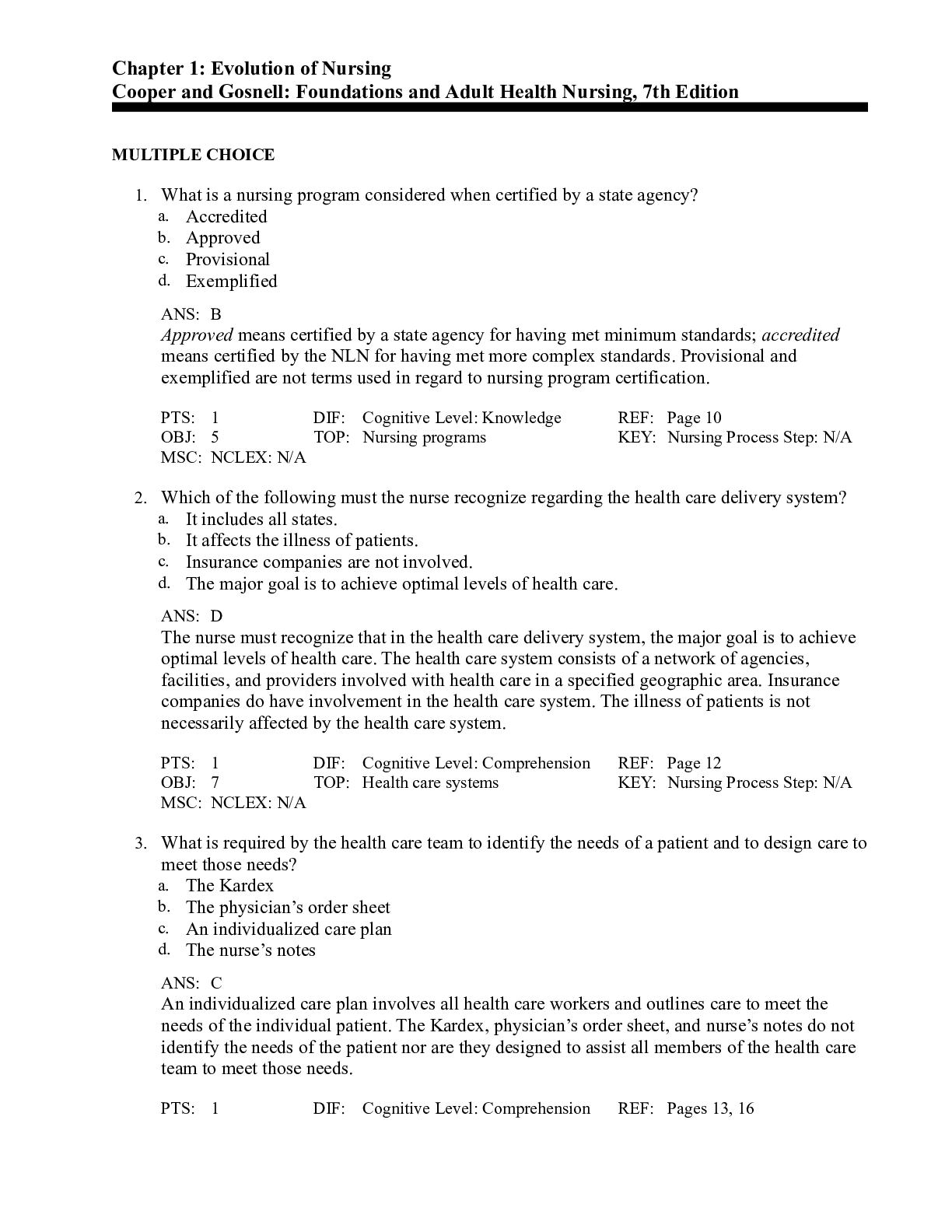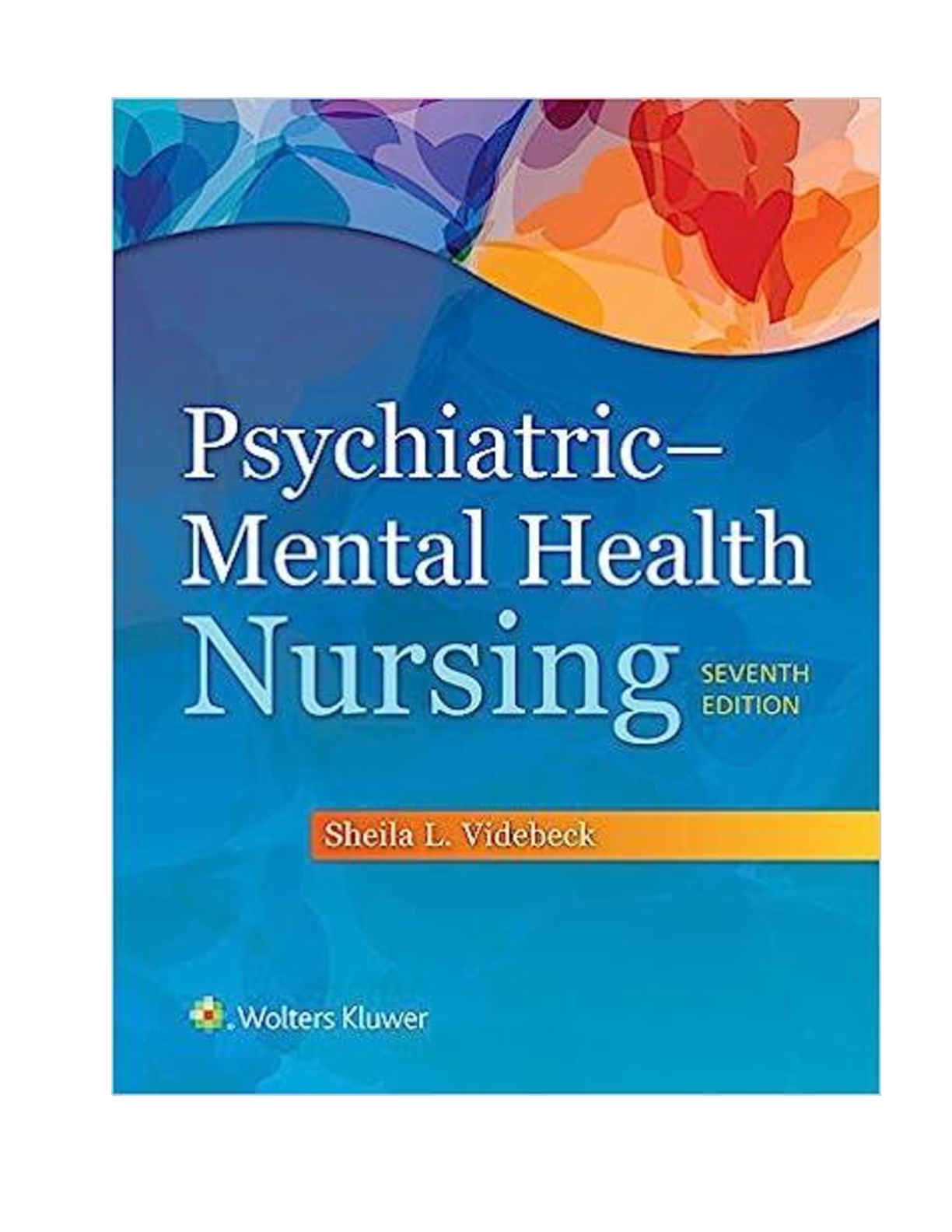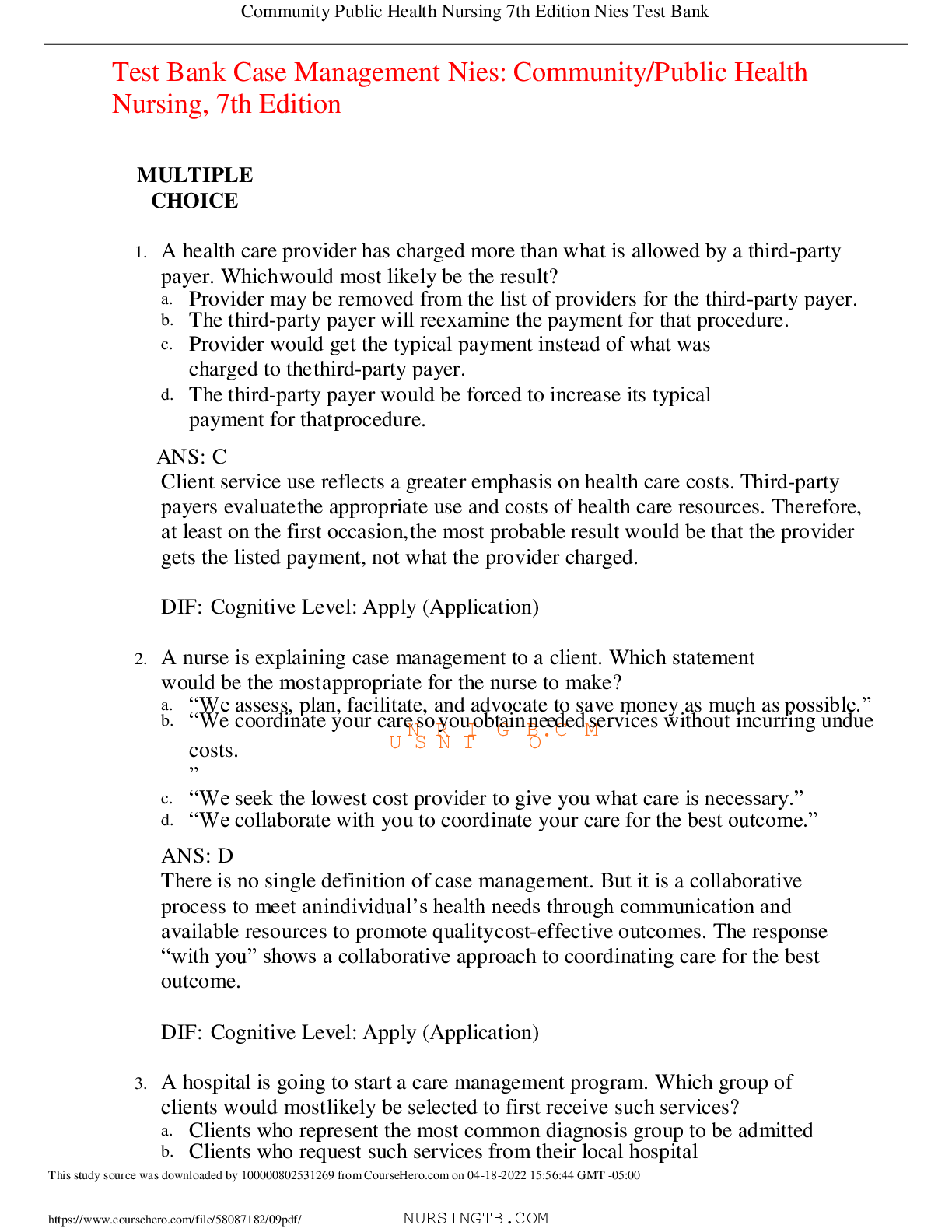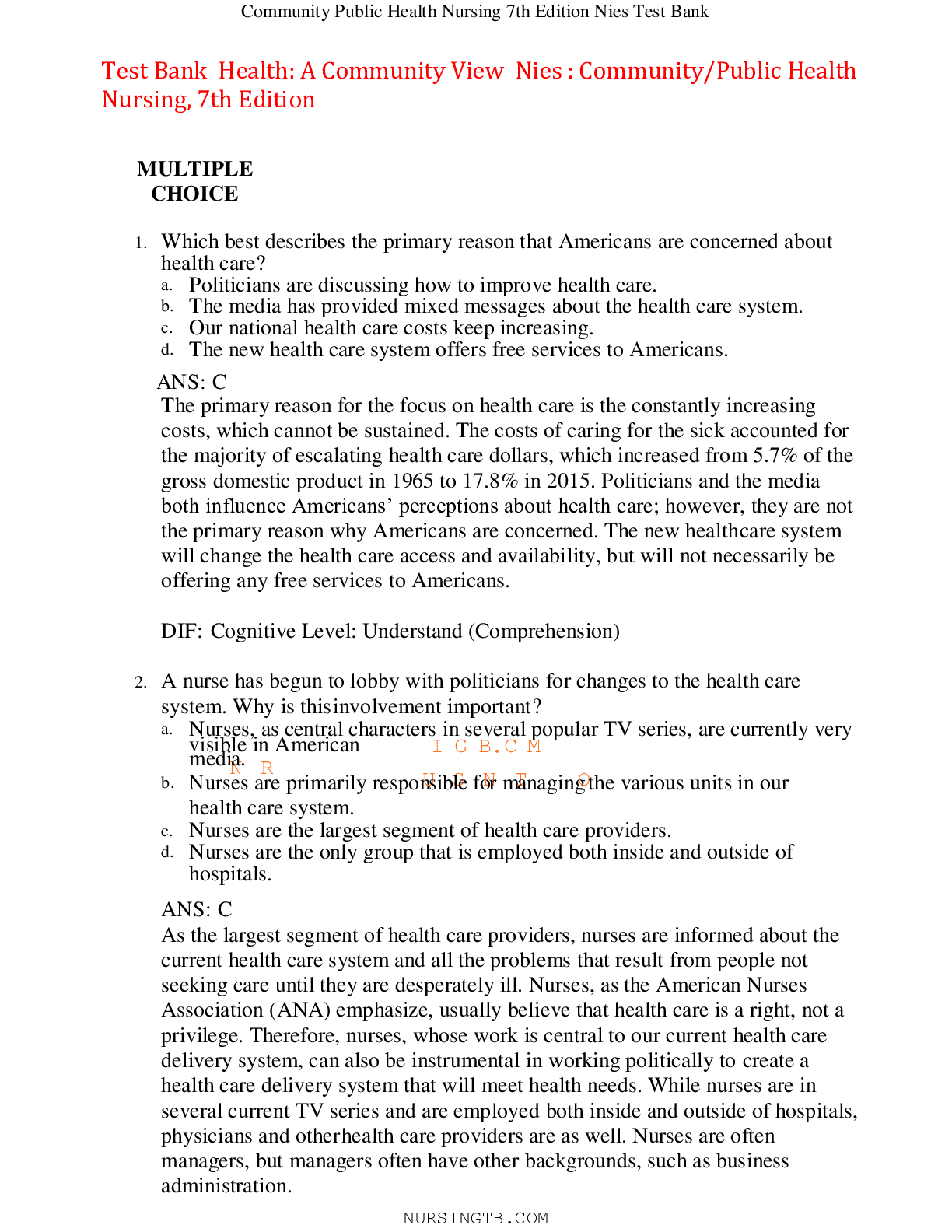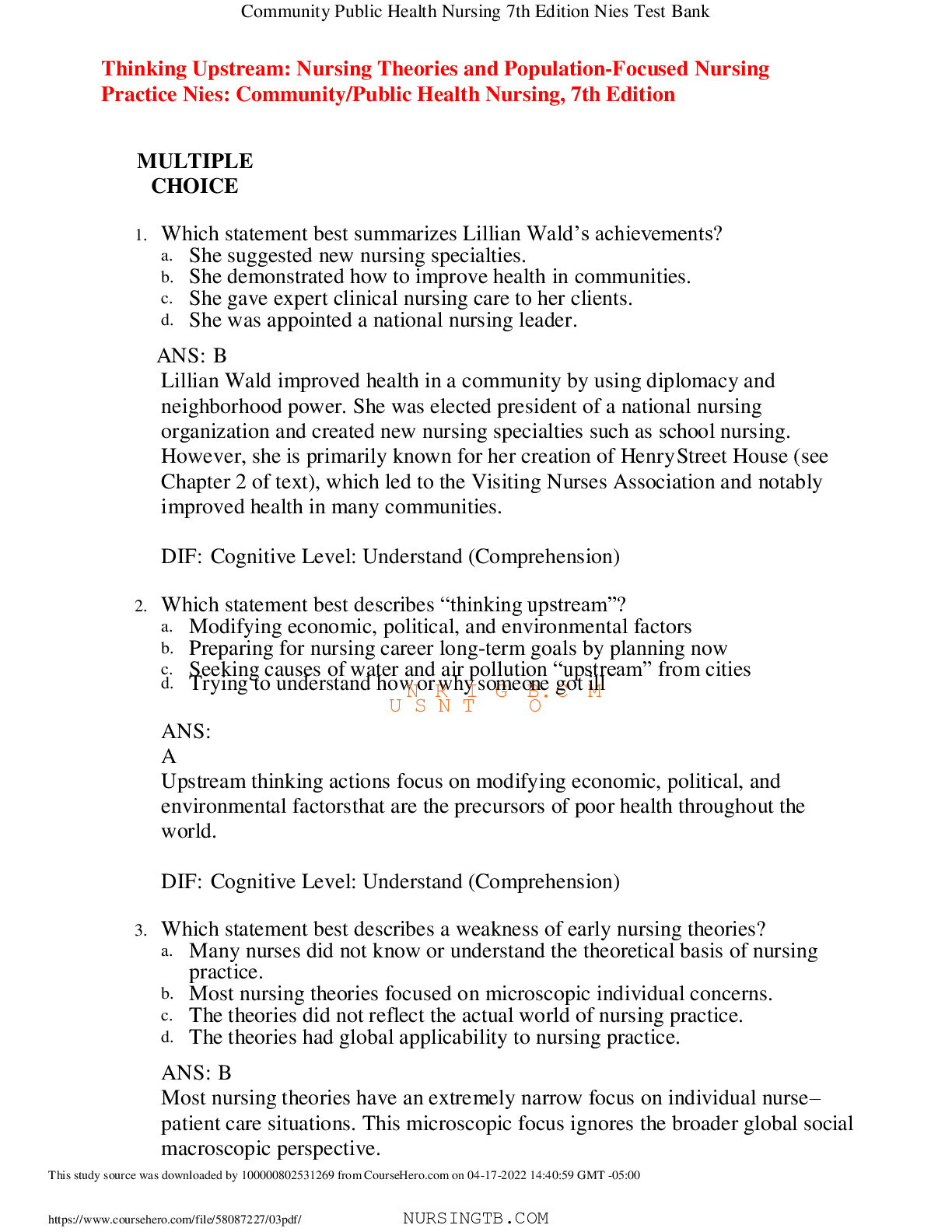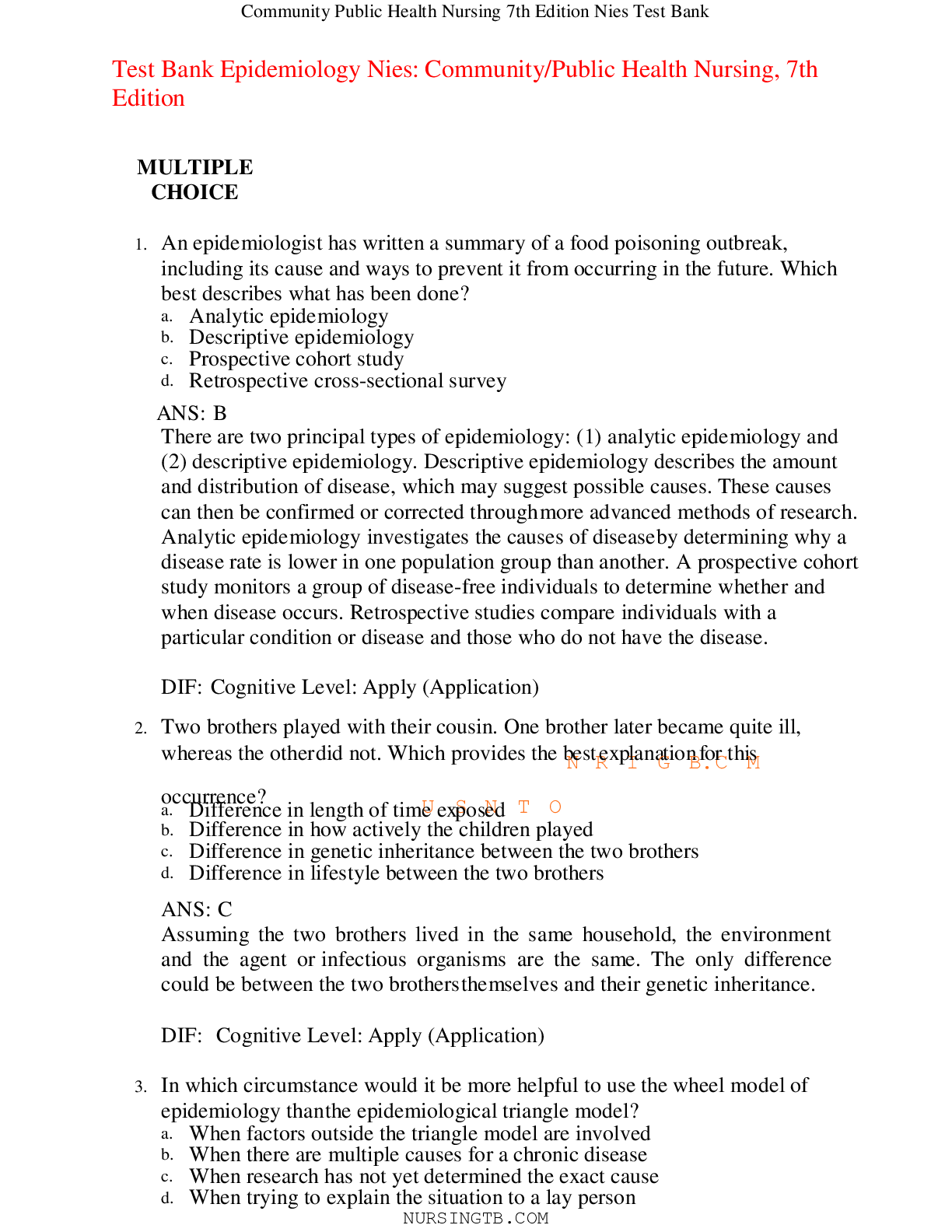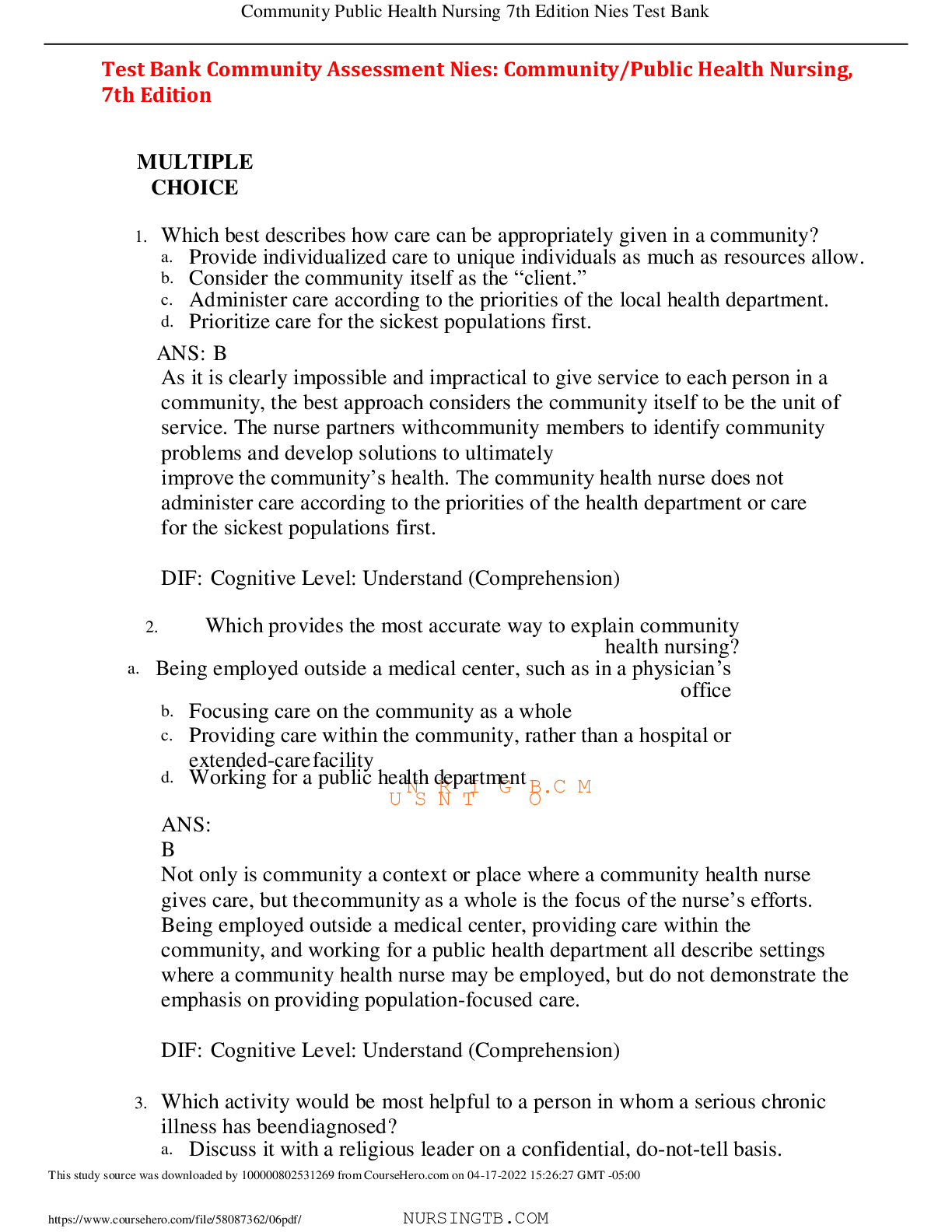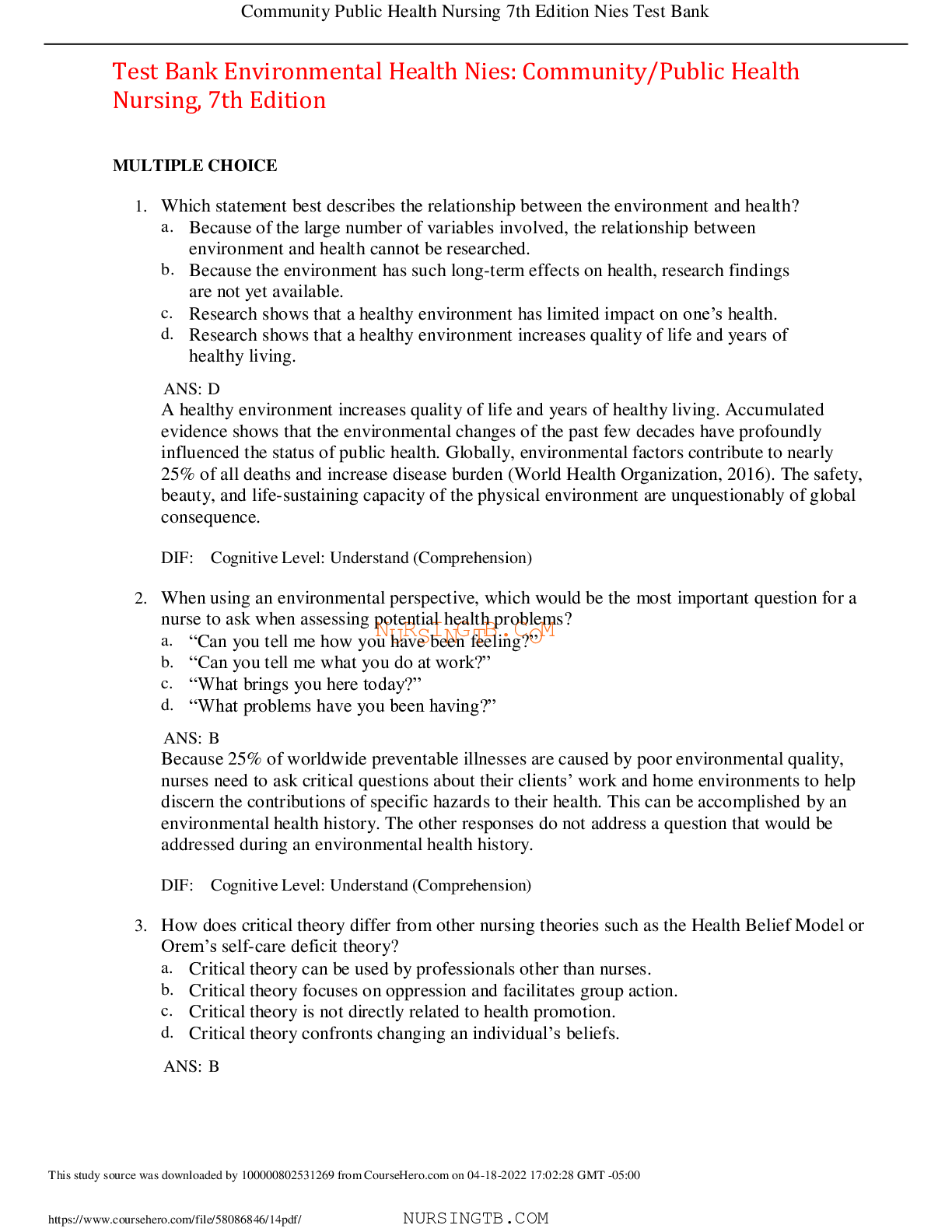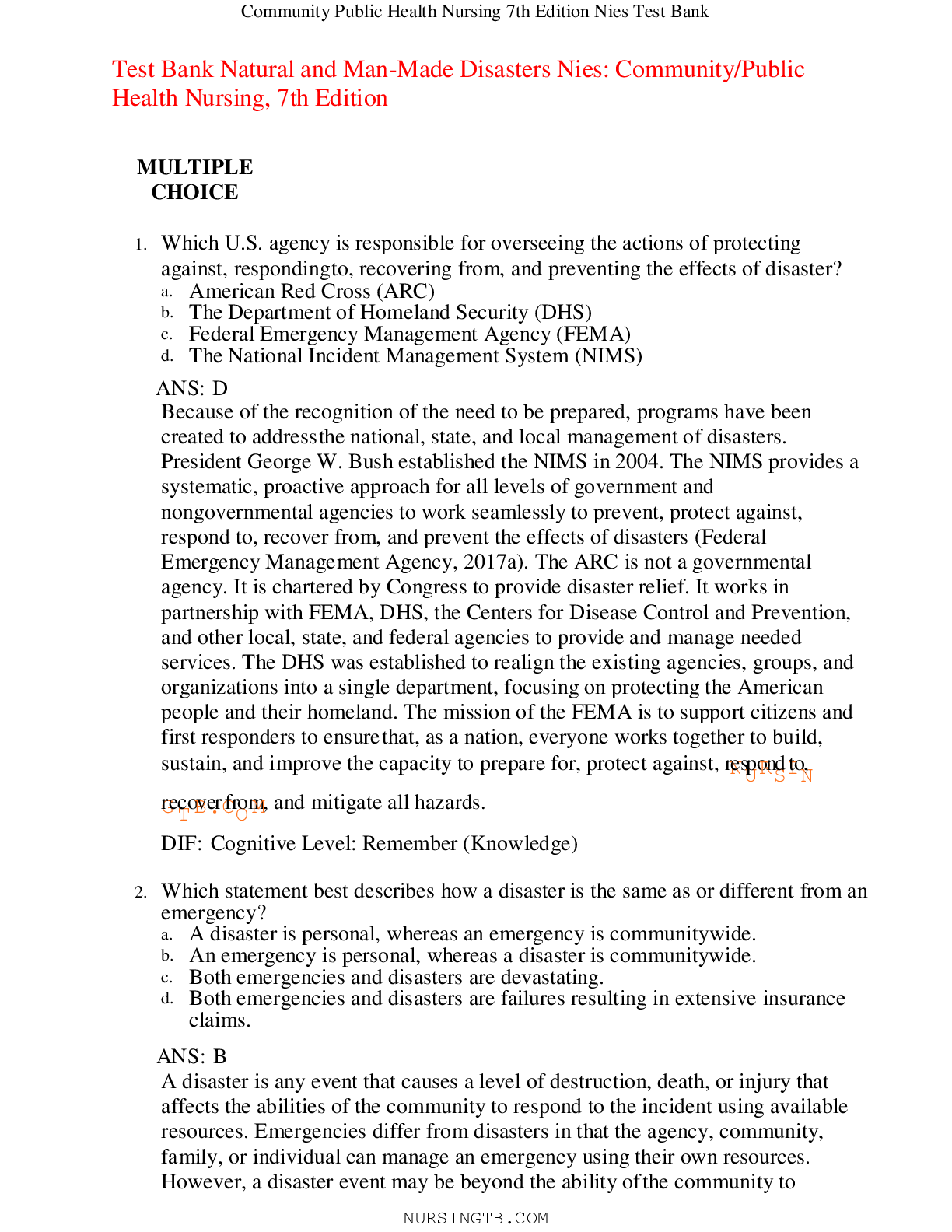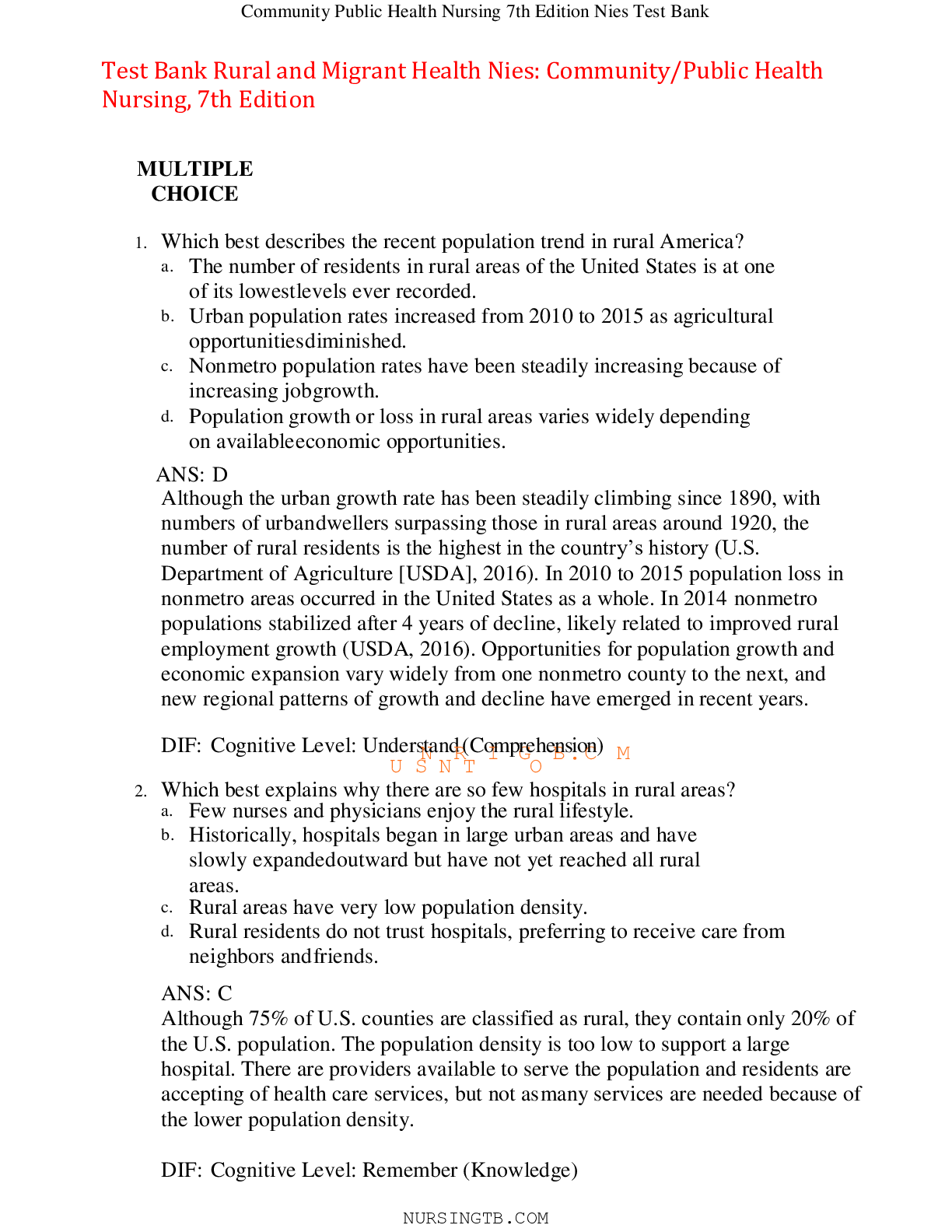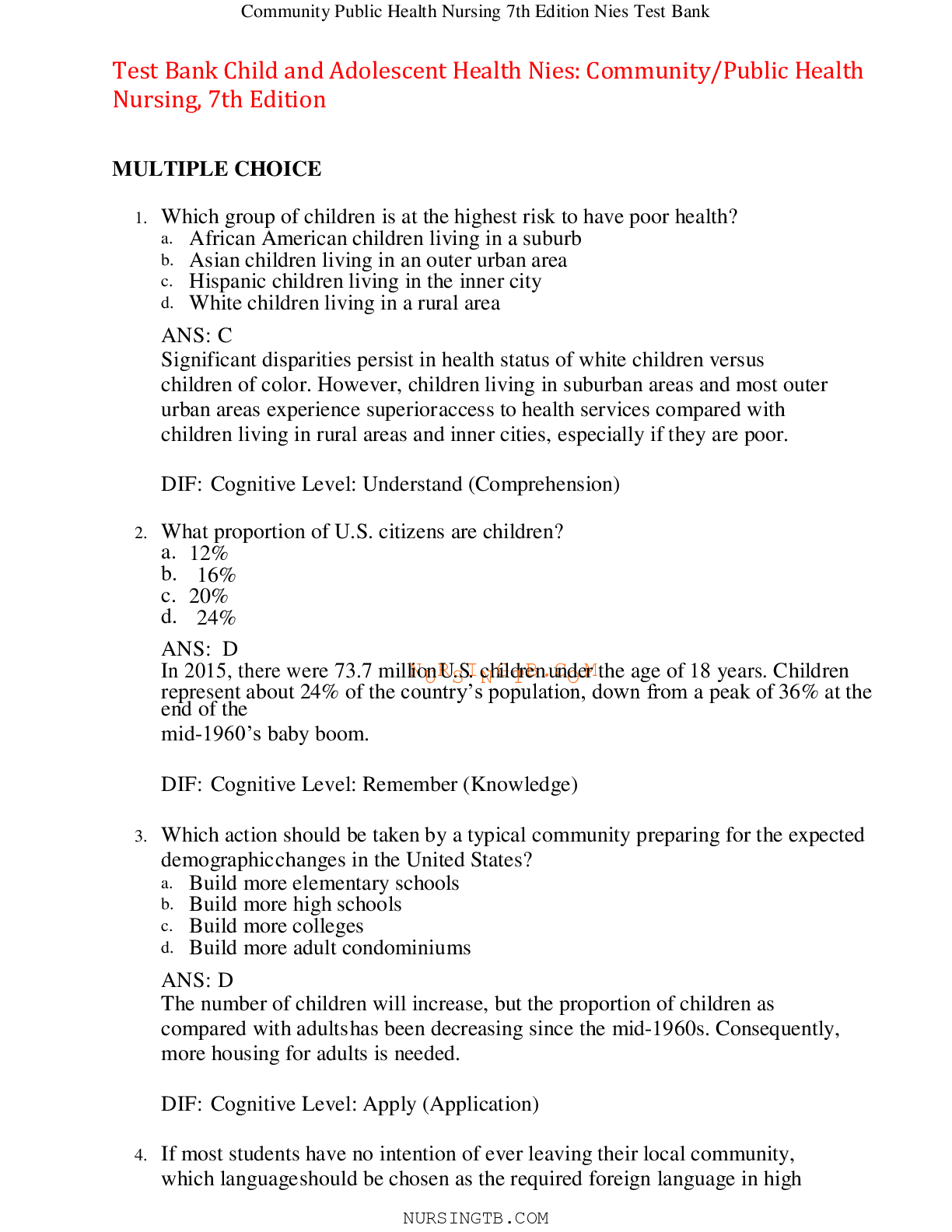*NURSING > TEST BANK > Test Bank Populations Affected by Disabilities Nies: Community/Public Health Nursing, 7th Edition,10 (All)
Test Bank Populations Affected by Disabilities Nies: Community/Public Health Nursing, 7th Edition,100% CORRECT
Document Content and Description Below
Test Bank Populations Affected by Disabilities Nies: Community/Public Health Nursing, 7th Edition MULTIPLE CHOICE 1. Which is an accurate definition of impairment? a. A disadvantage resulting... from a disability that prevents fulfillment of an expected role b. A restriction or inability to perform an activity in a normal manner c. A problem in body function or structure d. A defect that affects society on a macro level ANS: C Disability is an umbrella term describing impairments, activity limitations, and participation restrictions. An impairment is a problem in bodily function or structure. A handicap is a disadvantage resulting from an impairment or disability that prevents fulfillment of an expected role. In a comparison of these concepts, an impairment affects a human organ on a micro level; disability affects a person on an individual level; and a handicap involves society on a macro level of analysis. DIF: Cognitive Level: Remember (Knowledge) 2. Which problem depends on the responses of other people and therefore cannot be measured? a. Disability b. Handicap c. Impairment d. Injury ANS: B NURSINGTB.COM In comparing these concepts, an impairment affects a human organ on a micro level; disability affects a person on an individual level; and a handicap involves society on a macro level of analysis. Table 21.1 points out that both impairment and disability may be objective and measurable, whereas handicap is neither, because it is an experience related to the responses of other people. DIF: Cognitive Level: Understand (Comprehension) 3. Which statement regarding developmental disabilities is accurate? a. Those with developmental disabilities exhibit limitations before 18 years of age. b. Those with developmental disabilities see improvement in their functional ability as they age. c. Developmental disabilities are diagnosed before 1 year of age. d. Developmental disabilities result in a physical handicap. ANS: A Developmental disabilities encompass those conditions that are manifested by limitation before the legal age of adulthood, which is 18. This includes issues that limit or present challenges to the performance of activities of daily living (ADLs). Developmental disabilities encompass those lifelong conditions that are chronic in nature and may incorporate either or both intellectual and physical disabilities. Developmental disabilities can be diagnosed at any point in time during childhood. A handicap is not a characteristic of a person, but rather a description of the relationship between the person and the environment; a handicap results when a person with an impairment cannot fulfill a normal life role in society on a macro level of analysis. DIF: Cognitive Level: Understand (Comprehension) 4. Which insight is being stressed by advocacy groups regarding persons with disabilities today? a. Disability results when physical and social barriers in the environment prevent a person from taking equal part in community life. b. Handicapped persons have as much right to social support as nonhandicapped persons. c. It is recognized that an individual may be limited by an environmental barrier in society. d. Impairment is a result of society’s reaction more than mental or physical condition. ANS: A Nearly all definitions identify an individual as disabled on the basis of a physical or mental impairment that limits the person’s ability to perform an important activity. The complementary possibility—that the individual is limited by a barrier in society or the environment—is never considered. Advocacy groups, such as the Committee on a National Agenda for the Prevention of Disabilities, stress that environment and the reactions of others are as crucial as the actual phyUsicaSl or NmenTtal limiOtation. DIF: Cognitive Level: Understand (Comprehension) 5. Which concern can a nurse as a citizen help address? a. Advocating for removal of environmental and social barriers to needed services b. Continuing to engage in political action to increase funding for care for the handicapped c. Recognizing that it is better to offer to help than to wait for a person with handicaps to have to ask for assistance d. Needing to not stare or ask personal questions of a person with a disability ANS: A The Committee on a National Agenda for the Prevention of Disabilities model states disability occurs when a person’s physical or mental limitations, in interaction with physical and social barriers in the environment, prevent the person from taking equal part in the normal life of the community. Confronting environmental and social barriers to needed services can frustrate and exhaust many people with disabilities and their families. The nurse—as a citizen and a concerned professional—can advocate for removal of such barriers. This issue is the most important for the nurse to address, allowing the nurse to partner with clients and families affected by disabilities to remedy barriers that negatively affect quality of life for this population. DIF: Cognitive Level: Apply (Application) 6. A nurse is completing an assessment of a client who states that his chronic obstructive pulmonary disease (COPD) has worsened, and he is no longer able to do his own grocery shopping. Which stage of the NADP model is the client experiencing? a. Pathology b. Impairment c. Functional limitation d. Disability ANS: D The NAPD model provides an alternative framework for viewing four related and distinct stages in the disabling process. Pathology at the cellular and tissue levels may produce impairment in structure or function at the organ level. An individual with an impairment may experience a functional limitation, which restricts their ability to perform an action within the normal range. The functional limitation may result in a disability when certain socially defined activities and roles cannot be performed. Although the model appears to indicate unidirectional progression from pathology to impairment, to functional limitation, to disability, stepwise or linear progression may not occur. Disability prevention efforts can limit or reduce many of the risk factors or stages in the disabling process. DIF: Cognitive Level: Apply (Application) 7. A young man rolled his wheelchair up the ramp into the clinic to the desk where the intake nurse greeted him. After welcoming him to the clinic, which should be the initial question asked by the nurse? a. “Are you a vet home from the war?” b. “Can I help you into the treatment room to see the nurse practitioner?” c. “Do you have any family wUith SyouNto hTelp todOay?” d. “What brings you to the clinic today?” ANS: D The client should be asked what is needed just as any other client would be. A veteran would more probably be at a Veterans Affairs (VA) clinic, and there is nothing in the statement to imply that the clinic is part of the VA medical system. Because the man made it into the clinic, it is doubtful he would need help into the treatment room. Not all persons live with families. The handicap may be unrelated to why he is at the clinic. He may be ill or merely need immunization or other health promotion activity. DIF: Cognitive Level: Analyze (Analysis) 8. A young woman rolled her wheelchair up the ramp into the clinic to the desk where the intake nurse greeted her. Which should be the nurse’s first response? a. “How can I help you?” b. “Who came with you today?” c. Compliment her on her skill with the wheelchair d. Sit so the nurse is at wheelchair level with the young woman ANS: D Nurses who demonstrate understanding of the issues confronting people with disabilities should approach them at wheelchair level, listening to understand. Moving to wheelchair level should be the first action that the nurse takes before beginning a conversation with the client. DIF: Cognitive Level: Apply (Application) 9. Which best describes the proportion of the U.S. population that is made up of persons with a long-lasting condition or disability? a. The number is about 5% and increasing. b. The number is about 10% and stable. c. The proportion is about 15% and stable. d. The proportion is almost 20% and increasing. ANS: D In 2012, approximately 18.7 of those aged 5 years and older had a long-lasting condition or disability. As acquired age-related conditions occur during the lifespan, disability prevalence and disability severity levels rise with aging. In the United States, there is a shifting demographic of individuals living beyond the age of 65. Further, it is important for health care policy makers and health care providers to recognize that the prevalence of disability is increasing. DIF: Cognitive Level: Remember (Knowledge) 10. Which best describes the prevalence of disabilities in U.S. children under age 15? a. About 5% b. About 10% c. About 15% d. About 20% ANS: B More than 8% of U.S. childreNn uRndeIr theGagBe .ofC15 Mhave some kind of disability and about half of them were classified as having severe disabilities. DIF: Cognitive Level: Understand (Comprehension) 11. A nurse is caring for an individual with disabilities. Which would put this client at risk for the fatal four? a. A history of falls b. Immobility c. Anorexia d. A history of constipation ANS: D The term fatal four refers to four common medical conditions that could result in complications and fatality more frequently for the IDD population and other PWD. Nurses and primary care providers should be knowledgeable about the fatal four, which includes (1) constipation/bowel obstruction, (2) aspiration/gastroesophageal reflux disease (GERD), (3) dehydration, and (4) seizures, as complications related to these conditions could result in death if not assessed, diagnosed, and treated swiftly (Smith and Escude, 2015). The etiology of the fatal four includes polypharmacy, improper positioning, obesity, and dysphagia. DIF: Cognitive Level: Apply (Application) 12. Which describes the most important need of every school-aged child with a disability? a. A teacher who understands the child’s needs b. An advocate within the school system c. An assessment with comparison with developmental milestones d. An individualized education plan (IEP) ANS: D A child should have all of the above items, an advocate in the school nurse, a teacher who understands, an assessment including comparison with developmental milestones, as all of these are components of an IEP with goals, cooperatively developed with the parents, to help the child succeed in school. The IEP describes the goals, as well as any special support needed to help achieve them. The IEP is the most comprehensive answer. DIF: Cognitive Level: Understand (Comprehension) 13. Which best describes the current perspective on how communities should treat persons with disabilities (PWDs)? a. Be supportive of PWDs and try to reduce environmental barriers b. Maximize opportunities for PWDs to work and otherwise contribute to community life c. PWDs have civil rights just as other citizens do d. Recognize that PWDs deserve our support both financially and otherwise ANS: B Contemporary disability policy minimizes this disadvantaged view and maximizes opportunities for PWDs to live productively in their communities. Early American public policy viewed PWDs as “deserving poor” who required governmental protection and provision, with little capacity for self-support or independence. DIF: Cognitive Level: UndersNtaUndR(SCoImNpGreTheBns.ioCn)OM 14. A professional strongly encouraged institutionalization, so the parents could focus on care of their other family members. Which suggestion would be appropriate for the nurse to make to the parents? a. As the expert pointed out, institutionalization will reduce family stress. b. The child has a right to an education in the least-restrictive setting. c. The child will eventually adapt to whatever choice the parents make. d. The choice of what to do is entirely the parents’. ANS: B It is a given that it is the parents’ choice. As an advocate for the child, the nurse can explain that children have a legal right to an appropriate public education based on the child’s needs in the least-restrictive setting. This right is based on the Individuals with Disabilities Act (IDEA). DIF: Cognitive Level: Apply (Application) 15. A man came for follow-up care to the free clinic, explaining that he had applied for a job based on his education and years of previous work experience, but, being in a wheelchair, he was turned down. Which response would be most appropriate for the nurse? a. “If you know you can do the job, go to the free legal aid clinic for assistance. The employer may not know the law.” b. “No one would want to hire a handicapped person, so you can continue to come here for free care.” c. “Because it can be expensive to obtain the necessary equipment to help you do that job, the employer has every right to refuse to hire you.” d. “The law says, if a handicapped person applies, he or she has to get hired even if an able-bodied person also applies.” ANS: A The Americans with Disabilities Act (ADA) became law in 1990. This landmark civil rights-styled legislation prohibits discrimination toward people with disabilities in everyday activities by guaranteeing equal opportunities for people with disabilities related to employment, transportation, public accommodations, public services, and telecommunications. A qualified individual with a disability must meet legitimate skill, experience, education, or other requirements of an employment position. The person must be able to perform the essential functions of the job, such as those contained within a job description, with or without reasonable accommodations. DIF: Cognitive Level: Apply (Application) 16. Which problem was the Ticket to Work and Work Incentives Improvement Act (TWWIIA) designed to address? a. Employers trying to avoid hiring persons with disabilities b. Employers resenting being forced to hire persons with disabilities c. Persons with disabilities not being able to receive on-the-job training d. Persons with disabilities not seeking employment for fear of losing their health care and other governmental supports ANS: D Typically, people with disabiNliUtieRs ScoIuNldGqTuaBli.fyCfOorMsuch benefits as health care, income assistance programs, and personal care attendant services only if they chose not to work. To address employment and benefit issues for persons with disabilities, in December 1999, the TWWIIA was signed into law. The TWWIIA reduced people with disabilities’ disincentives to work by increasing access to vocational services and provided new methods for retaining health insurance after returning to work. DIF: Cognitive Level: Understand (Comprehension) 17. Which statement about Supplemental Security Income (SSI) and Social Security Disability Insurance (SSDI) is correct? a. SSI is funded through disability trust fund monies. b. To qualify for SSDI, the person with disabilities must have limited income and resources. c. SSDI recipients receive Medicaid health benefits. d. Persons with disabilities who receive SSI may receive a state supplement. ANS: D SSI is funded through general tax revenues, whereas SSDI is funded through disability trust fund monies (Social Security taxes paid by workers, employers, and self-employed workers). To qualify for SSDI, the person with disabilities must be “insured” through Federal Insurance Contributions Act (FICA) earnings of self, parents, and/or spouse, and to qualify for SSI, the person with disabilities must have limited income and resources. SSDI recipients receive Medicare health benefits, and SSI recipients receive Medicaid health benefits. Some states may elect to pay a state supplement to some persons with disabilities in SSI programs, whereas in SSDI programs persons with disabilities are never provided with state supplements. DIF: Cognitive Level: Understand (Comprehension) 18. Which best describes the prevalence of autism in the United States? a. The prevalence of autism has increased in the past decade. b. The prevalence of autism has decreased in the past decade. c. The prevalence of autism has remained stable in the past decade. d. Because the etiology is unknown, it is difficult to determine the prevalence of autism. ANS: A It has been estimated that about 1 in 88 children (or slightly more than 1.1%) have autism. Alarmingly, between 2000 and 2010, autism’s prevalence increased 119%, with estimates at 1 in 68 births. Autism has no known etiology, but more frequently occurs among older parents. DIF: Cognitive Level: Understand (Comprehension) 19. A nurse came limping into work with a huge cast on her right leg and asked to have an assignment for a week or two tUhat Sdid Nnot TrequireOdriving. The nurse said, “I never realized how difficult it is to get some places without two good legs. Now I know how persons with disabilities must feel!” Which would be the most appropriate response from the nursing supervisor? a. “I’m sure you’ll be even more understanding and supportive now.” b. “Not really; you’ll be out of that cast in a few weeks.” c. “What a great opportunity to attend some support groups for people with disabilities and share with us which ones are most helpful.” d. “Why don’t you just take some sick leave rather than try to work with that leg cast?” ANS: B Those who have a temporary disability have a very different experience than those who are permanently disabled. Although they may experience frustrations, they view it as a temporary problem and a temporary setback. The other responses address this temporary disability as if it is similar to a permanent disability, which it clearly is not. DIF: Cognitive Level: Apply (Application) 20. A mother has recently learned that her infant has been diagnosed with spina bifida. Which nutrient was lacking during gestation? a. Calcium b. Vitamin K c. Folic acid d. Vitamin D ANS: C SB occurs when there is failure of the neural tube to close during the 28 day of gestation. SB is associated with deficits in motor, sensory, and physical differences that may be largely prevented with proper folic acid intake during gestation. Adequate folic acid supplementation is important for prevention of neural tube development. DIF: Cognitive Level: Apply (Application) 21. A nurse eagerly explained to a long-term disabled male client the most recent relevant research related to his care. The client, rather than express appreciation, said, “I prefer to have my care given this way.” The nurse explained that research suggested an alternative approach was more clinically effective, but the client said, “I am more comfortable during the day if my care is given this way.” Which action should be taken by the nurse? a. Accept that the client knows what works best b. Ask the nursing supervisor to review the research with the client c. Give evidence-based care according to current research findings d. Negotiate a compromise between patient preferences and research-based approach to care ANS: A A person who lives with a disability commonly becomes an expert at knowing what works best for his or her body. The nurse must ask the client what works best for him or her and what goals the client is pursuing. Research is based on probabilities of effectiveness with large groups, but individuals may have a different unique reaction to any intervention. DIF: Cognitive Level: Apply N(AUpRplSicaItiNonG) TB.COM 22. Which best describes why some advocacy groups have taken a strong stand against physician-assisted suicide? a. Ethical belief that life is always preferable to death b. Emphasis that there is always hope for a research breakthrough or discovery of a new treatment intervention c. Fear that some persons may be “encouraged” to accept an early death merely because they are not valued by society for their contributions d. Helping someone die is murder, plain, and simple ANS: C Because people have previously been killed because they had a disability, some advocacy groups, such as Not Dead Yet, have taken a strong stance against physician-assisted suicide, fearing it will lead to the early or forced death of people with disability. Ethical and personal beliefs and emphasizing the hope for a new treatment have not been stands taken by advocacy groups against physician-assisted suicide. DIF: Cognitive Level: Understand (Comprehension) MULTIPLE RESPONSE 1. A nurse is caring for an individual with intellectual and developmental disabilities (IDD). Which findings would be most concerning to the nurse? (Select all that apply.) a. Poor skin turgor b. Decreased appetite c. Increased urination d. No bowel movement for the past 3 days e. Symptoms of choking after taking a sip of water f. Recent seizure ANS: A, D, E, F The term fatal four refers to four common medical conditions that could result in complications and fatality more frequently for the IDD population and other PWD. Nurses and primary care providers should be knowledgeable about the fatal four, which includes (1) constipation/bowel obstruction—as evidenced by no bowel movement for the past 3 days, (2) aspiration/gastroesophageal reflux disease (GERD)—as evidenced by choking on a sip of water, (3) dehydration—as evidenced by poor skin turgor, and (4) seizures—as complications related to these conditions could result in death if not assessed, diagnosed, and treated swiftly (Smith and Escude, 2015). DIF: Cognitive Level: Analyze (Analysis) 2. Which are strategies the nurse should practice to provide effective care for persons with disabilities? (Select all that apply.) a. Apologize for slips of the tongue such as saying “Do you see?” to a blind person. b. Don’t assume the client has a physical or cognitive deficit until you have validated it. c. Allocate additional time for care. d. Take hold of a blind person’s arm to assist them in dangerous situations, such as crossing a busy street. NURSINGTB.COM e. Volunteer the most recent research findings related to the person’s disability. f. Adopt the client’s perspective as to what works best without bias. ANS: B, C, F The acronym developed that spells ADVOCATE can help remind and guide the nurse of essential principles that are integral to the care of PWD. A—Advocate, D—Deficits, V—Vocation, O—Outcomes, C—Communicate, A—Assess, T—Transition, E—Empower. Effective strategies include not making assumptions about deficits before they have been validated; allocating additional time for care as necessary; adopting the client’s perspective as to what works best without bias. Ineffective strategies include apologizing for errors, offering expert opinions or advise, and grabbing the arm of a person who is blind. DIF: Cognitive Level: Understand (Comprehension) [Show More]
Last updated: 1 year ago
Preview 1 out of 17 pages
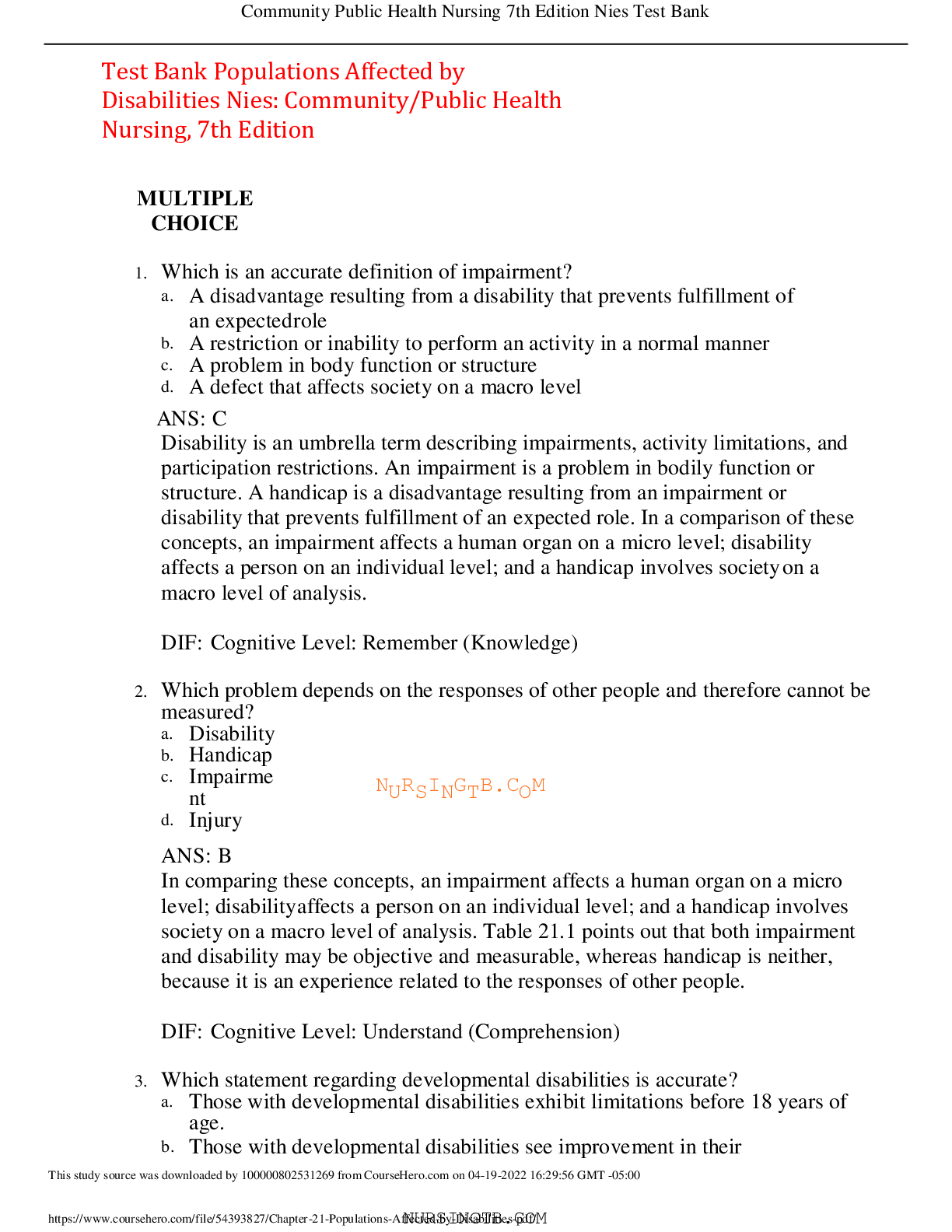
Reviews( 0 )
Document information
Connected school, study & course
About the document
Uploaded On
May 03, 2022
Number of pages
17
Written in
Additional information
This document has been written for:
Uploaded
May 03, 2022
Downloads
0
Views
31




